HRM 3105 - Value of Technology in HR: Annotated Bibliography
VerifiedAdded on 2023/05/30
|6
|1535
|443
Annotated Bibliography
AI Summary
This annotated bibliography examines the impact of technology on human resource management, drawing on five peer-reviewed articles. The articles explore various aspects, including the influence of information technology on HR practices, the role of technology in creating value and innovation in service systems, the performance implications of information and technology in e-service systems, the link between information technology capability and firm performance, and the effects of information and communication technology in transition economies. The sources provide insights into the benefits and risks of technology adoption, the importance of resource strategies, and the challenges faced by firms in adapting to technological advancements. The bibliography highlights the evolving relationship between technology and human resource management, emphasizing the need for strategic implementation and adaptation to ensure organizational success. The articles also discuss the impact of technology on communication, customer relationship management, and overall firm performance in both established and transitioning economies.
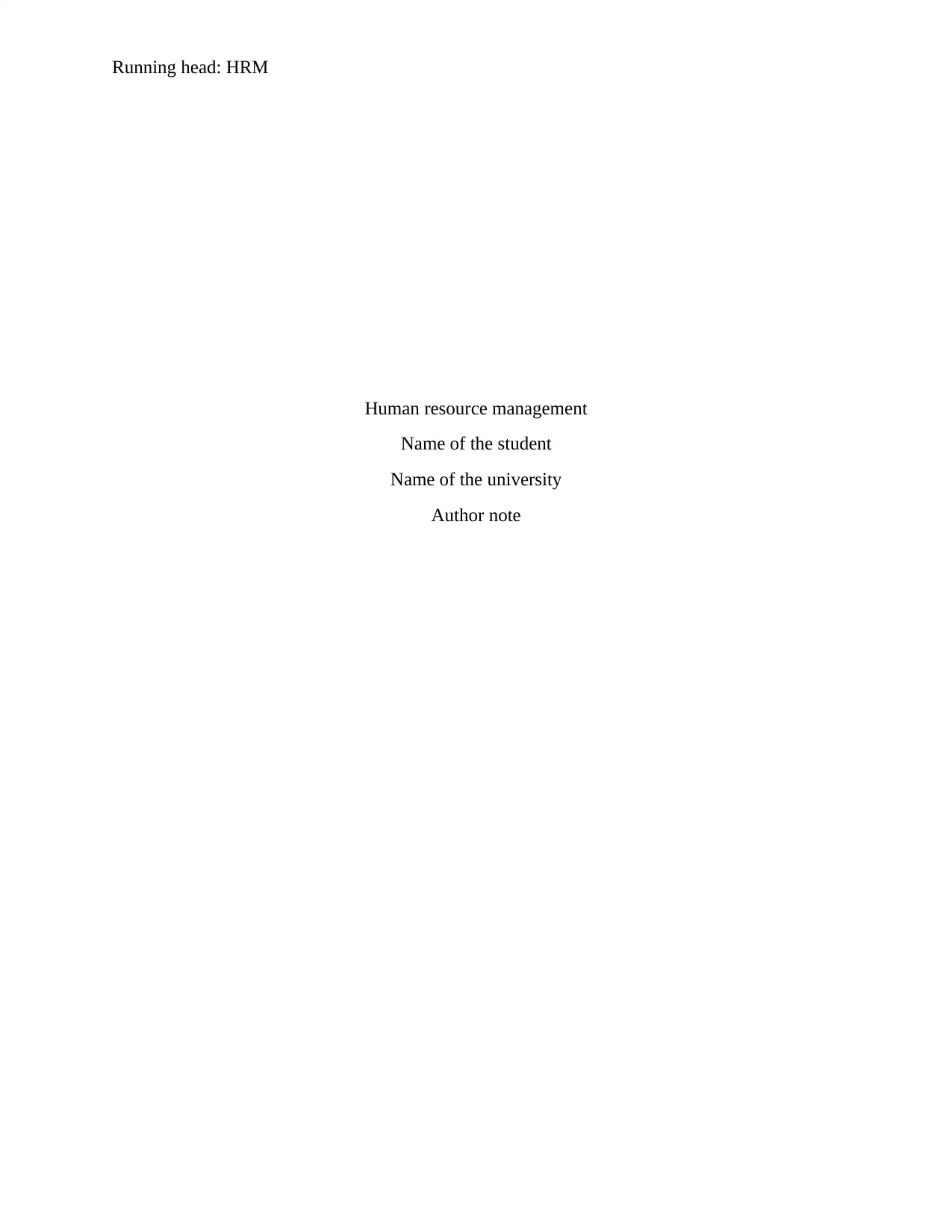
Running head: HRM
Human resource management
Name of the student
Name of the university
Author note
Human resource management
Name of the student
Name of the university
Author note
Paraphrase This Document
Need a fresh take? Get an instant paraphrase of this document with our AI Paraphraser
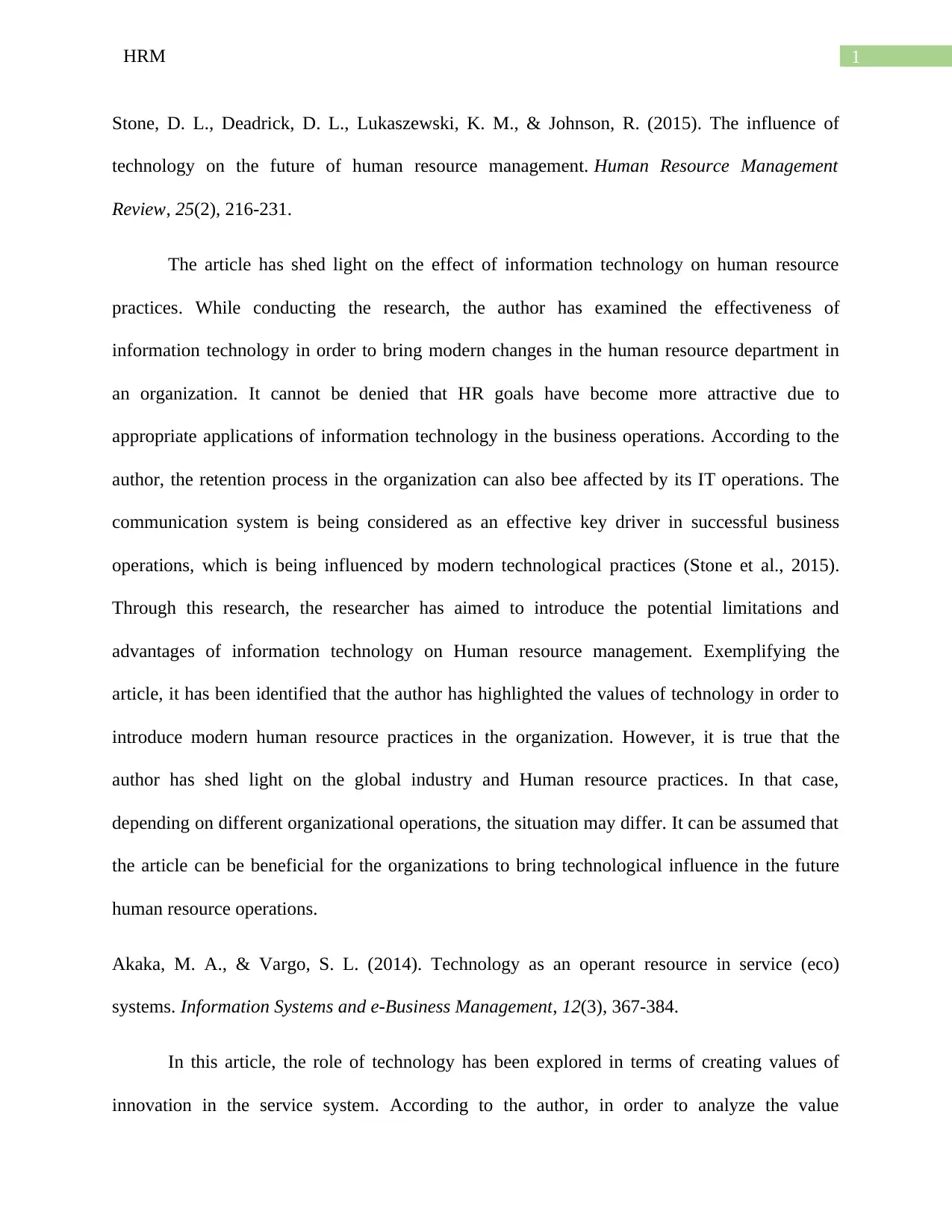
1HRM
Stone, D. L., Deadrick, D. L., Lukaszewski, K. M., & Johnson, R. (2015). The influence of
technology on the future of human resource management. Human Resource Management
Review, 25(2), 216-231.
The article has shed light on the effect of information technology on human resource
practices. While conducting the research, the author has examined the effectiveness of
information technology in order to bring modern changes in the human resource department in
an organization. It cannot be denied that HR goals have become more attractive due to
appropriate applications of information technology in the business operations. According to the
author, the retention process in the organization can also bee affected by its IT operations. The
communication system is being considered as an effective key driver in successful business
operations, which is being influenced by modern technological practices (Stone et al., 2015).
Through this research, the researcher has aimed to introduce the potential limitations and
advantages of information technology on Human resource management. Exemplifying the
article, it has been identified that the author has highlighted the values of technology in order to
introduce modern human resource practices in the organization. However, it is true that the
author has shed light on the global industry and Human resource practices. In that case,
depending on different organizational operations, the situation may differ. It can be assumed that
the article can be beneficial for the organizations to bring technological influence in the future
human resource operations.
Akaka, M. A., & Vargo, S. L. (2014). Technology as an operant resource in service (eco)
systems. Information Systems and e-Business Management, 12(3), 367-384.
In this article, the role of technology has been explored in terms of creating values of
innovation in the service system. According to the author, in order to analyze the value
Stone, D. L., Deadrick, D. L., Lukaszewski, K. M., & Johnson, R. (2015). The influence of
technology on the future of human resource management. Human Resource Management
Review, 25(2), 216-231.
The article has shed light on the effect of information technology on human resource
practices. While conducting the research, the author has examined the effectiveness of
information technology in order to bring modern changes in the human resource department in
an organization. It cannot be denied that HR goals have become more attractive due to
appropriate applications of information technology in the business operations. According to the
author, the retention process in the organization can also bee affected by its IT operations. The
communication system is being considered as an effective key driver in successful business
operations, which is being influenced by modern technological practices (Stone et al., 2015).
Through this research, the researcher has aimed to introduce the potential limitations and
advantages of information technology on Human resource management. Exemplifying the
article, it has been identified that the author has highlighted the values of technology in order to
introduce modern human resource practices in the organization. However, it is true that the
author has shed light on the global industry and Human resource practices. In that case,
depending on different organizational operations, the situation may differ. It can be assumed that
the article can be beneficial for the organizations to bring technological influence in the future
human resource operations.
Akaka, M. A., & Vargo, S. L. (2014). Technology as an operant resource in service (eco)
systems. Information Systems and e-Business Management, 12(3), 367-384.
In this article, the role of technology has been explored in terms of creating values of
innovation in the service system. According to the author, in order to analyze the value
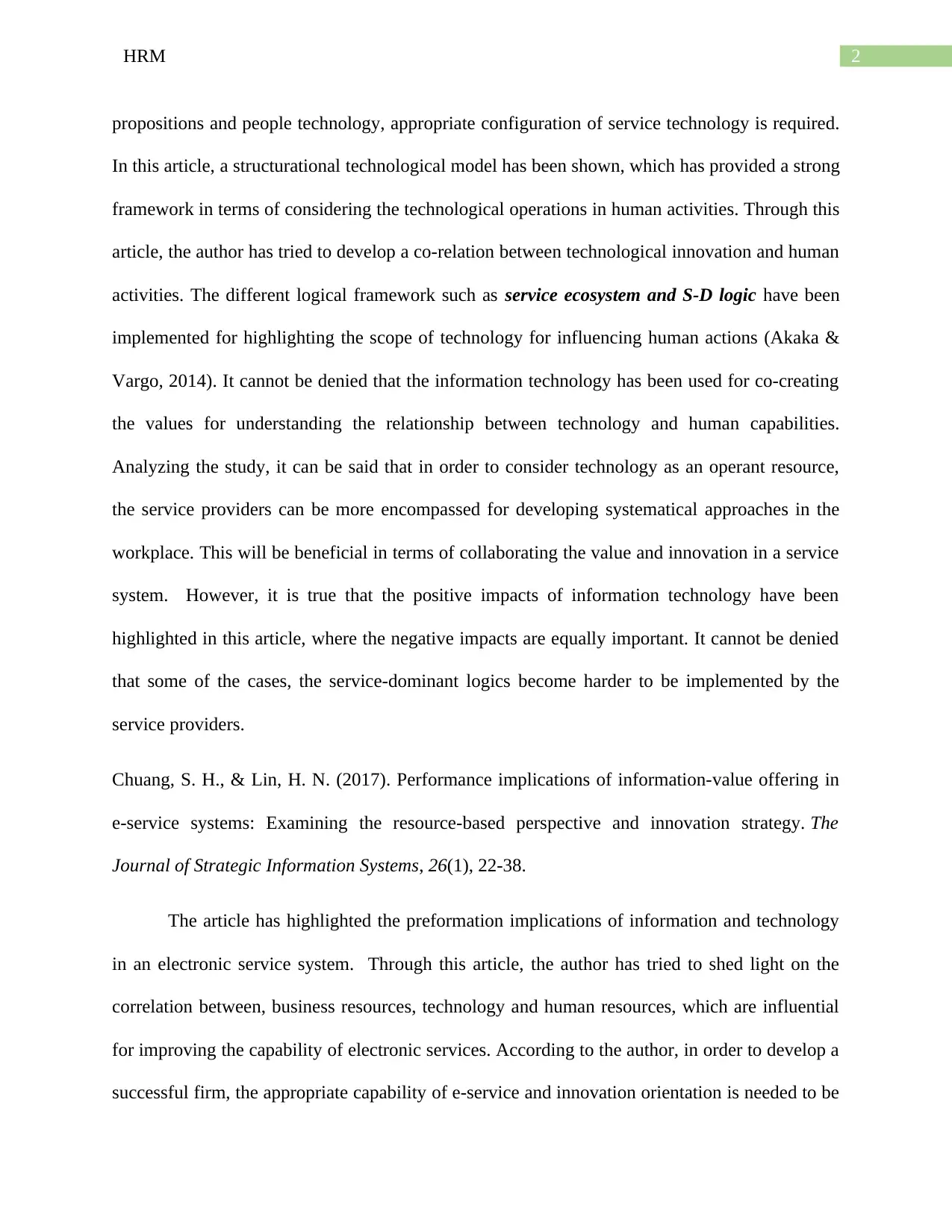
2HRM
propositions and people technology, appropriate configuration of service technology is required.
In this article, a structurational technological model has been shown, which has provided a strong
framework in terms of considering the technological operations in human activities. Through this
article, the author has tried to develop a co-relation between technological innovation and human
activities. The different logical framework such as service ecosystem and S-D logic have been
implemented for highlighting the scope of technology for influencing human actions (Akaka &
Vargo, 2014). It cannot be denied that the information technology has been used for co-creating
the values for understanding the relationship between technology and human capabilities.
Analyzing the study, it can be said that in order to consider technology as an operant resource,
the service providers can be more encompassed for developing systematical approaches in the
workplace. This will be beneficial in terms of collaborating the value and innovation in a service
system. However, it is true that the positive impacts of information technology have been
highlighted in this article, where the negative impacts are equally important. It cannot be denied
that some of the cases, the service-dominant logics become harder to be implemented by the
service providers.
Chuang, S. H., & Lin, H. N. (2017). Performance implications of information-value offering in
e-service systems: Examining the resource-based perspective and innovation strategy. The
Journal of Strategic Information Systems, 26(1), 22-38.
The article has highlighted the preformation implications of information and technology
in an electronic service system. Through this article, the author has tried to shed light on the
correlation between, business resources, technology and human resources, which are influential
for improving the capability of electronic services. According to the author, in order to develop a
successful firm, the appropriate capability of e-service and innovation orientation is needed to be
propositions and people technology, appropriate configuration of service technology is required.
In this article, a structurational technological model has been shown, which has provided a strong
framework in terms of considering the technological operations in human activities. Through this
article, the author has tried to develop a co-relation between technological innovation and human
activities. The different logical framework such as service ecosystem and S-D logic have been
implemented for highlighting the scope of technology for influencing human actions (Akaka &
Vargo, 2014). It cannot be denied that the information technology has been used for co-creating
the values for understanding the relationship between technology and human capabilities.
Analyzing the study, it can be said that in order to consider technology as an operant resource,
the service providers can be more encompassed for developing systematical approaches in the
workplace. This will be beneficial in terms of collaborating the value and innovation in a service
system. However, it is true that the positive impacts of information technology have been
highlighted in this article, where the negative impacts are equally important. It cannot be denied
that some of the cases, the service-dominant logics become harder to be implemented by the
service providers.
Chuang, S. H., & Lin, H. N. (2017). Performance implications of information-value offering in
e-service systems: Examining the resource-based perspective and innovation strategy. The
Journal of Strategic Information Systems, 26(1), 22-38.
The article has highlighted the preformation implications of information and technology
in an electronic service system. Through this article, the author has tried to shed light on the
correlation between, business resources, technology and human resources, which are influential
for improving the capability of electronic services. According to the author, in order to develop a
successful firm, the appropriate capability of e-service and innovation orientation is needed to be
⊘ This is a preview!⊘
Do you want full access?
Subscribe today to unlock all pages.

Trusted by 1+ million students worldwide
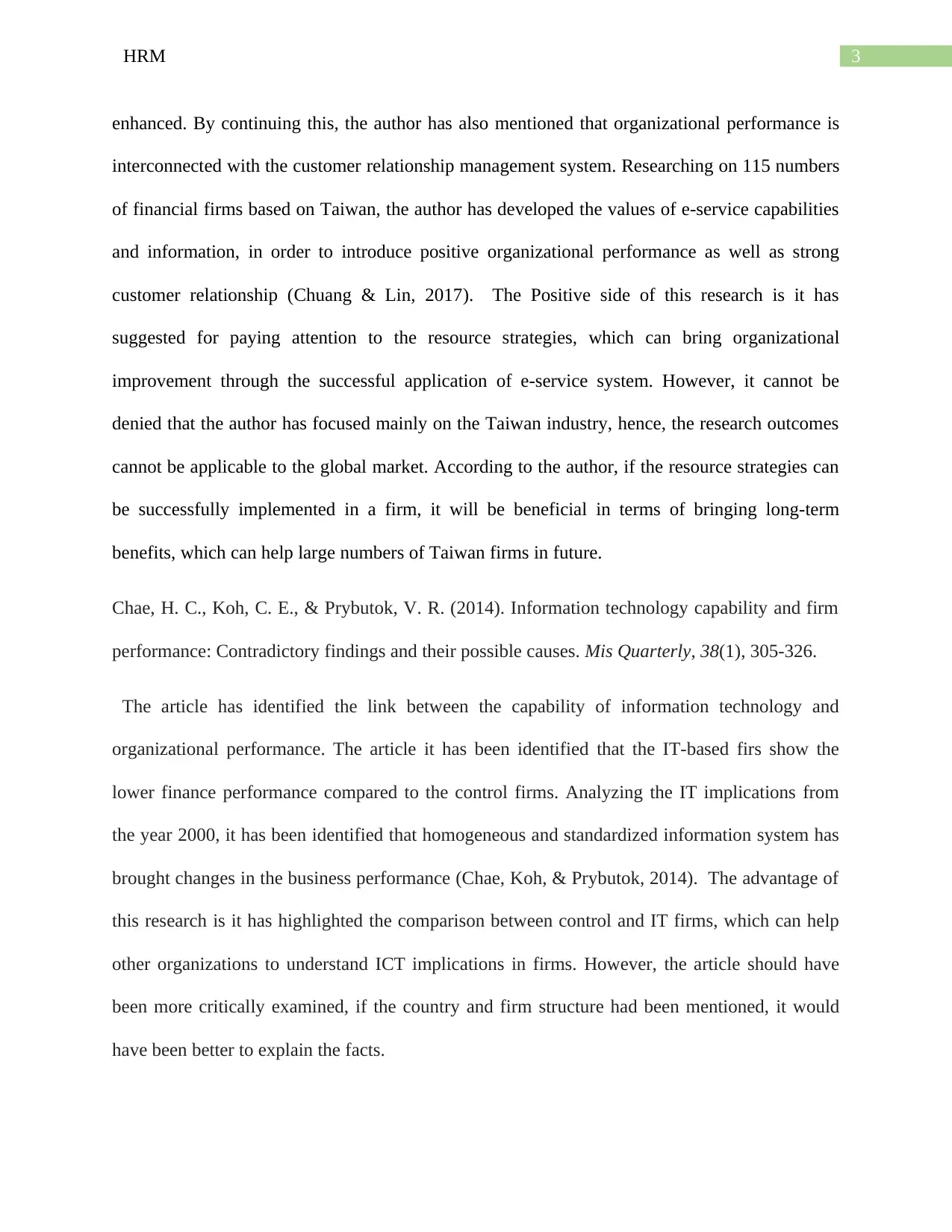
3HRM
enhanced. By continuing this, the author has also mentioned that organizational performance is
interconnected with the customer relationship management system. Researching on 115 numbers
of financial firms based on Taiwan, the author has developed the values of e-service capabilities
and information, in order to introduce positive organizational performance as well as strong
customer relationship (Chuang & Lin, 2017). The Positive side of this research is it has
suggested for paying attention to the resource strategies, which can bring organizational
improvement through the successful application of e-service system. However, it cannot be
denied that the author has focused mainly on the Taiwan industry, hence, the research outcomes
cannot be applicable to the global market. According to the author, if the resource strategies can
be successfully implemented in a firm, it will be beneficial in terms of bringing long-term
benefits, which can help large numbers of Taiwan firms in future.
Chae, H. C., Koh, C. E., & Prybutok, V. R. (2014). Information technology capability and firm
performance: Contradictory findings and their possible causes. Mis Quarterly, 38(1), 305-326.
The article has identified the link between the capability of information technology and
organizational performance. The article it has been identified that the IT-based firs show the
lower finance performance compared to the control firms. Analyzing the IT implications from
the year 2000, it has been identified that homogeneous and standardized information system has
brought changes in the business performance (Chae, Koh, & Prybutok, 2014). The advantage of
this research is it has highlighted the comparison between control and IT firms, which can help
other organizations to understand ICT implications in firms. However, the article should have
been more critically examined, if the country and firm structure had been mentioned, it would
have been better to explain the facts.
enhanced. By continuing this, the author has also mentioned that organizational performance is
interconnected with the customer relationship management system. Researching on 115 numbers
of financial firms based on Taiwan, the author has developed the values of e-service capabilities
and information, in order to introduce positive organizational performance as well as strong
customer relationship (Chuang & Lin, 2017). The Positive side of this research is it has
suggested for paying attention to the resource strategies, which can bring organizational
improvement through the successful application of e-service system. However, it cannot be
denied that the author has focused mainly on the Taiwan industry, hence, the research outcomes
cannot be applicable to the global market. According to the author, if the resource strategies can
be successfully implemented in a firm, it will be beneficial in terms of bringing long-term
benefits, which can help large numbers of Taiwan firms in future.
Chae, H. C., Koh, C. E., & Prybutok, V. R. (2014). Information technology capability and firm
performance: Contradictory findings and their possible causes. Mis Quarterly, 38(1), 305-326.
The article has identified the link between the capability of information technology and
organizational performance. The article it has been identified that the IT-based firs show the
lower finance performance compared to the control firms. Analyzing the IT implications from
the year 2000, it has been identified that homogeneous and standardized information system has
brought changes in the business performance (Chae, Koh, & Prybutok, 2014). The advantage of
this research is it has highlighted the comparison between control and IT firms, which can help
other organizations to understand ICT implications in firms. However, the article should have
been more critically examined, if the country and firm structure had been mentioned, it would
have been better to explain the facts.
Paraphrase This Document
Need a fresh take? Get an instant paraphrase of this document with our AI Paraphraser
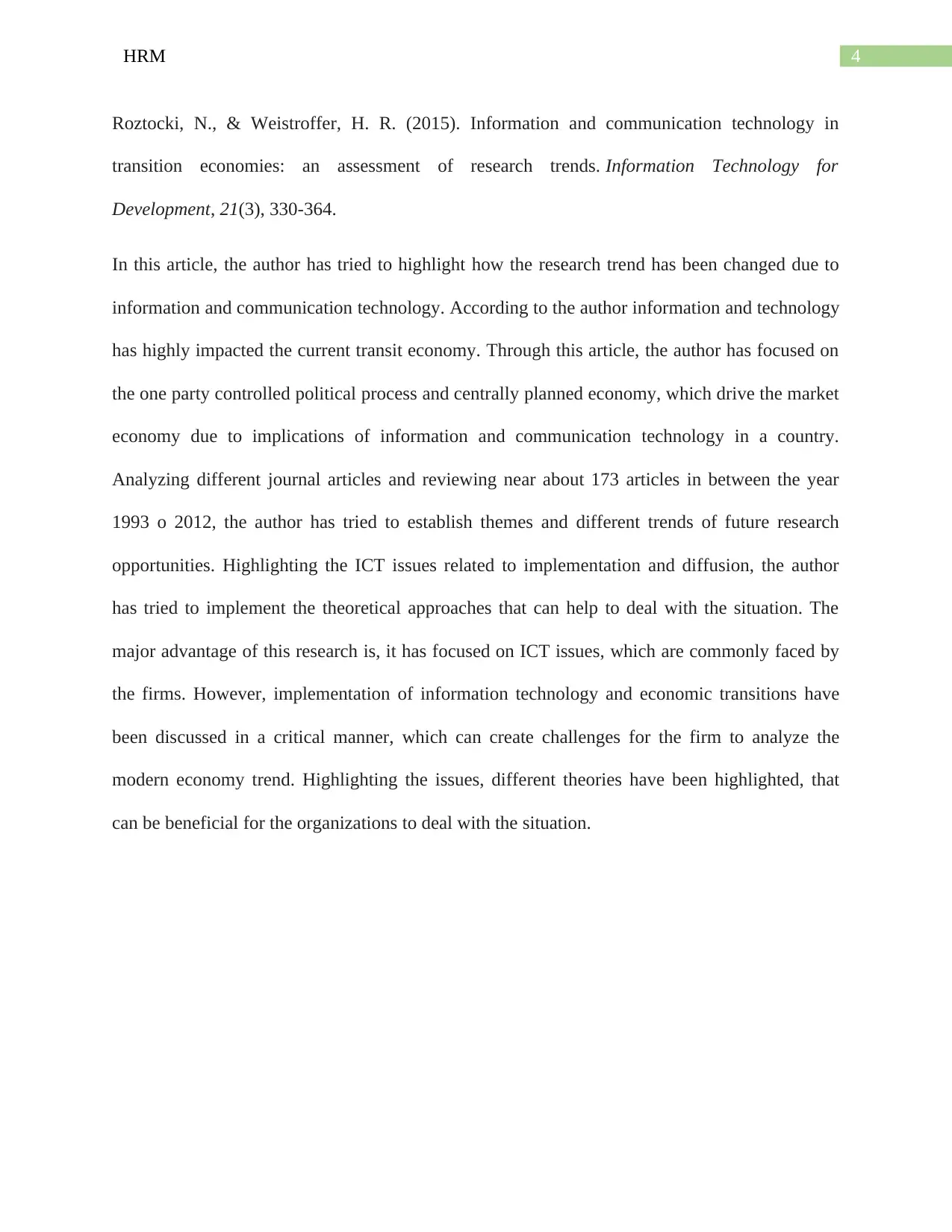
4HRM
Roztocki, N., & Weistroffer, H. R. (2015). Information and communication technology in
transition economies: an assessment of research trends. Information Technology for
Development, 21(3), 330-364.
In this article, the author has tried to highlight how the research trend has been changed due to
information and communication technology. According to the author information and technology
has highly impacted the current transit economy. Through this article, the author has focused on
the one party controlled political process and centrally planned economy, which drive the market
economy due to implications of information and communication technology in a country.
Analyzing different journal articles and reviewing near about 173 articles in between the year
1993 o 2012, the author has tried to establish themes and different trends of future research
opportunities. Highlighting the ICT issues related to implementation and diffusion, the author
has tried to implement the theoretical approaches that can help to deal with the situation. The
major advantage of this research is, it has focused on ICT issues, which are commonly faced by
the firms. However, implementation of information technology and economic transitions have
been discussed in a critical manner, which can create challenges for the firm to analyze the
modern economy trend. Highlighting the issues, different theories have been highlighted, that
can be beneficial for the organizations to deal with the situation.
Roztocki, N., & Weistroffer, H. R. (2015). Information and communication technology in
transition economies: an assessment of research trends. Information Technology for
Development, 21(3), 330-364.
In this article, the author has tried to highlight how the research trend has been changed due to
information and communication technology. According to the author information and technology
has highly impacted the current transit economy. Through this article, the author has focused on
the one party controlled political process and centrally planned economy, which drive the market
economy due to implications of information and communication technology in a country.
Analyzing different journal articles and reviewing near about 173 articles in between the year
1993 o 2012, the author has tried to establish themes and different trends of future research
opportunities. Highlighting the ICT issues related to implementation and diffusion, the author
has tried to implement the theoretical approaches that can help to deal with the situation. The
major advantage of this research is, it has focused on ICT issues, which are commonly faced by
the firms. However, implementation of information technology and economic transitions have
been discussed in a critical manner, which can create challenges for the firm to analyze the
modern economy trend. Highlighting the issues, different theories have been highlighted, that
can be beneficial for the organizations to deal with the situation.
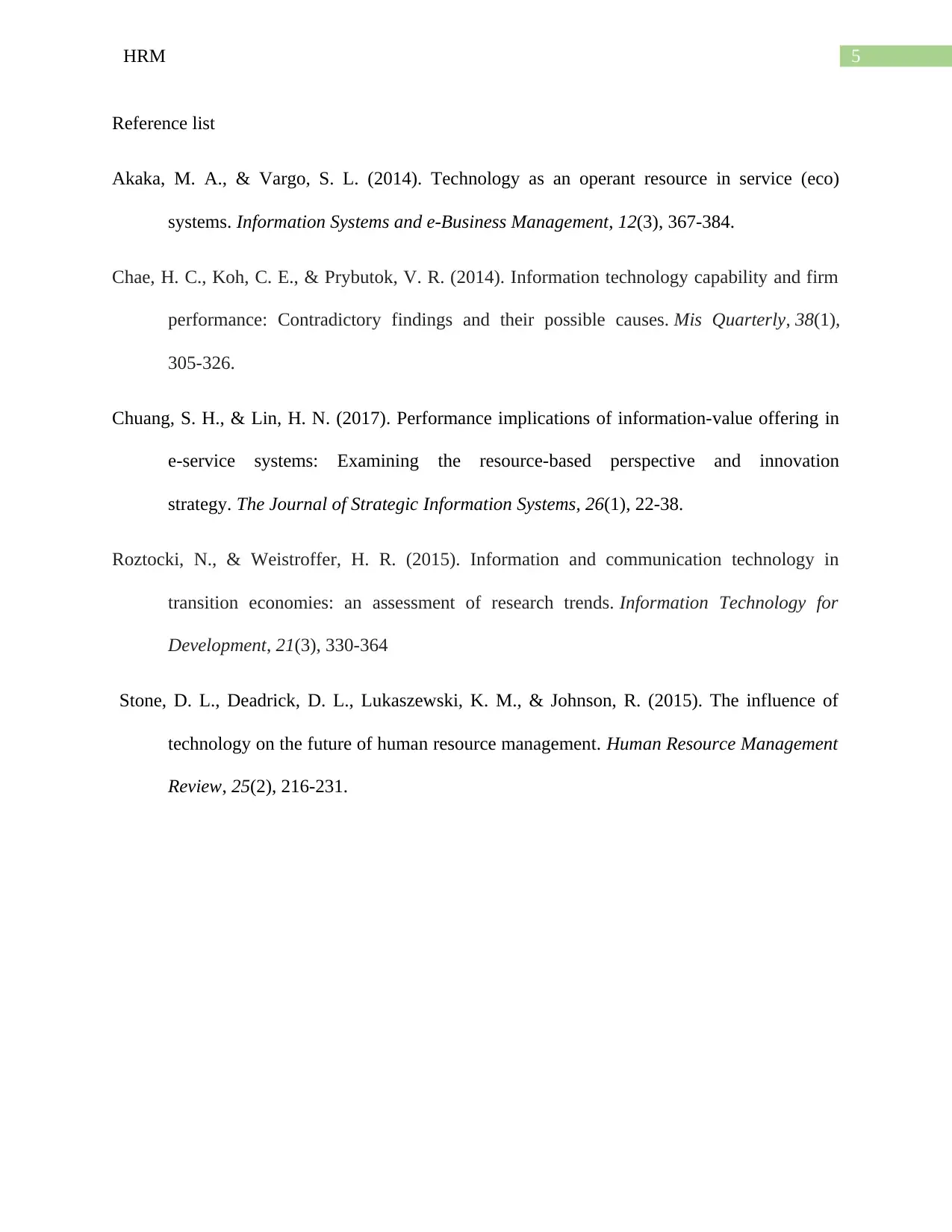
5HRM
Reference list
Akaka, M. A., & Vargo, S. L. (2014). Technology as an operant resource in service (eco)
systems. Information Systems and e-Business Management, 12(3), 367-384.
Chae, H. C., Koh, C. E., & Prybutok, V. R. (2014). Information technology capability and firm
performance: Contradictory findings and their possible causes. Mis Quarterly, 38(1),
305-326.
Chuang, S. H., & Lin, H. N. (2017). Performance implications of information-value offering in
e-service systems: Examining the resource-based perspective and innovation
strategy. The Journal of Strategic Information Systems, 26(1), 22-38.
Roztocki, N., & Weistroffer, H. R. (2015). Information and communication technology in
transition economies: an assessment of research trends. Information Technology for
Development, 21(3), 330-364
Stone, D. L., Deadrick, D. L., Lukaszewski, K. M., & Johnson, R. (2015). The influence of
technology on the future of human resource management. Human Resource Management
Review, 25(2), 216-231.
Reference list
Akaka, M. A., & Vargo, S. L. (2014). Technology as an operant resource in service (eco)
systems. Information Systems and e-Business Management, 12(3), 367-384.
Chae, H. C., Koh, C. E., & Prybutok, V. R. (2014). Information technology capability and firm
performance: Contradictory findings and their possible causes. Mis Quarterly, 38(1),
305-326.
Chuang, S. H., & Lin, H. N. (2017). Performance implications of information-value offering in
e-service systems: Examining the resource-based perspective and innovation
strategy. The Journal of Strategic Information Systems, 26(1), 22-38.
Roztocki, N., & Weistroffer, H. R. (2015). Information and communication technology in
transition economies: an assessment of research trends. Information Technology for
Development, 21(3), 330-364
Stone, D. L., Deadrick, D. L., Lukaszewski, K. M., & Johnson, R. (2015). The influence of
technology on the future of human resource management. Human Resource Management
Review, 25(2), 216-231.
⊘ This is a preview!⊘
Do you want full access?
Subscribe today to unlock all pages.

Trusted by 1+ million students worldwide
1 out of 6
Related Documents
Your All-in-One AI-Powered Toolkit for Academic Success.
+13062052269
info@desklib.com
Available 24*7 on WhatsApp / Email
![[object Object]](/_next/static/media/star-bottom.7253800d.svg)
Unlock your academic potential
Copyright © 2020–2025 A2Z Services. All Rights Reserved. Developed and managed by ZUCOL.





